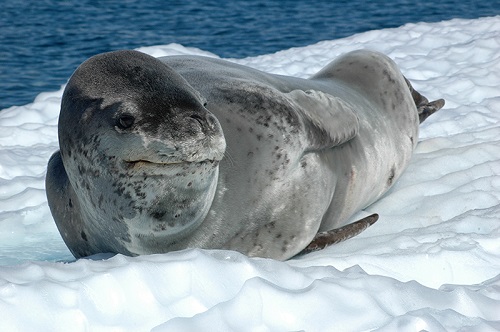 NOAA scientists Mike Goebel and Doug Krause wear a lot of hats when they travel to the Antarctic Peninsula – at any one time, they are pilots, cameramen, seal studiers, and above all, observers. Both men work are using innovative technologies like unmanned aerial systems (UAS) and Crittercams to study fish and wildlife in one of the most remote locations on the planet. It’s all in a day’s work that they do for NOAA Fisheries’ Southwest Fisheries Science Center’s Antarctic Ecosystem Research Division.
NOAA scientists Mike Goebel and Doug Krause wear a lot of hats when they travel to the Antarctic Peninsula – at any one time, they are pilots, cameramen, seal studiers, and above all, observers. Both men work are using innovative technologies like unmanned aerial systems (UAS) and Crittercams to study fish and wildlife in one of the most remote locations on the planet. It’s all in a day’s work that they do for NOAA Fisheries’ Southwest Fisheries Science Center’s Antarctic Ecosystem Research Division.

Goebel and Krause recently sat down to tell us more:

There is a growing need to document the effects of climate change on fish and marine mammal species and populations. How are unmanned aerial systems and Crittercams allowing you to do that in novel ways?
MG: The western Antarctic Peninsula is one of three areas on the planet that are warming the fastest, so research about environmental impacts from climate change is important. UAS allow scientists to study large areas of territory safely, which wasn’t always possible or practical with other types of technology. Also, this region is frequently cloudy, so obtaining quality satellite data is difficult; UAS data are a more practical way to take aerial photos of animal colonies – like those of penguins and seals – and get accurate estimates of the number of individuals in a population.
DK: Crittercams, those small video cameras mounted to animals’ bodies to record their movements, are more focused on individual animal behavior, so they help us understand how that behavior might change in the face of a changing climate and changing resources such as food supply. Our work with National Geographic Crittercams helps us answer questions like how an apex predator at the top of the food chain, like a leopard seal, might change its behavior to adapt to climate change.
The technologies we talked about today are helping you study Antarctic ecosystems in ways that weren’t possible even five to 10 years ago. What’s the next step?

MG: In the short term, software is being designed to send out and return a UAS to a “home base” aboard a research vessel, rather than a land-based field station. This will make it possible to deploy UAS from zodiac boats to investigate small islands humans can’t reach. We can also expand regional UAS work into areas of the Antarctic that haven’t been explored yet, and look at the effects of climate change and fishing on penguins and seals. We also want to look at unmanned underwater systems that would crisscross an area under observation and take various other offshore environmental measurements. Essentially, we want to get the underwater equivalent of what UAS do in the sky.
DK: I think Crittercams and NOAA Fisheries have a common goal, and that is constant improvement. For Crittercams, that means working towards smaller cameras, longer measurement times and reducing the potential effects on animals. One addition that we are working to add to the Crittercam is a hydrophone because underwater sounds are so important to understanding the behavior of animals. Improving technologies are crucial for these really awesome scientific breakthroughs. But the most critical thing is always going to be having set of eyes, a notebook and a brain to pull everything together and look at the big picture.
Learn more about how NOAA Fisheries is improving its observational capacity
in the Antarctic.

